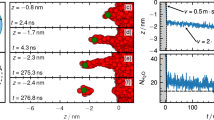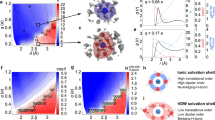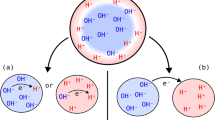Abstract
Solvation is a ubiquitous phenomenon in the natural sciences. At the macroscopic level, it is well understood through thermodynamics and chemical reaction kinetics1,2. At the atomic level, the primary steps of solvation are the attraction and binding of individual molecules or atoms of a solvent to molecules or ions of a solute1. These steps have, however, never been observed in real time. Here we instantly create a single sodium ion at the surface of a liquid helium nanodroplet3,4, and measure the number of solvent atoms that successively attach to the ion as a function of time. We found that the binding dynamics of the first five helium atoms is well described by a Poissonian process with a binding rate of 2.0 atoms per picosecond. This rate is consistent with time-dependent density-functional-theory simulations of the solvation process. Furthermore, our measurements enable an estimate of the energy removed from the region around the sodium ion as a function of time, revealing that half of the total solvation energy is dissipated after four picoseconds. Our experimental method opens possibilities for benchmarking theoretical models of ion solvation and for time-resolved measurements of cation–molecule complex formation.
This is a preview of subscription content, access via your institution
Access options
Access Nature and 54 other Nature Portfolio journals
Get Nature+, our best-value online-access subscription
$29.99 / 30 days
cancel any time
Subscribe to this journal
Receive 51 print issues and online access
$199.00 per year
only $3.90 per issue
Buy this article
- Purchase on Springer Link
- Instant access to full article PDF
Prices may be subject to local taxes which are calculated during checkout




Similar content being viewed by others
Data availability
The data supporting the findings of this study are available within the paper and its Supplementary Information. Should any raw data files be needed in another format, they are available from the corresponding author upon reasonable request. Source data are provided with this paper.
Code availability
The computing code used for the TDDFT simulations (M. Pi et al. 4He-DFT BCN-TLS: A Computer Package for Simulating Structural Properties and Dynamics of Doped Liquid Helium-4 Systems) is freely available at https://github.com/bcntls2016/. The code for the molecular dynamics simulations can be obtained upon request.
References
Reichardt, C. & Welton, T. Solvents and Solvent Effects in Organic Chemistry (Wiley, 2011).
Marcus, Y. Ions in Solution and Their Solvation (John Wiley & Sons, 2015).
Toennies, J. P. & Vilesov, A. F. Superfluid helium droplets: a uniquely cold nanomatrix for molecules and molecular complexes. Angew. Chem. Int. Edn 43, 2622–2648 (2004).
Choi, M. Y. et al. Infrared spectroscopy of helium nanodroplets: novel methods for physics and chemistry. Int. Rev. Phys. Chem. 25, 15–75 (2006).
Jarzeba, W., Walker, G. C., Johnson, A. E., Kahlow, M. A. & Barbara, P. F. Femtosecond microscopic solvation dynamics of aqueous solutions. J. Phys. Chem. 92, 7039–7041 (1988).
Jimenez, R., Fleming, G. R., Kumar, P. V. & Maroncelli, M. Femtosecond solvation dynamics of water. Nature 369, 471–473 (1994).
de Boeij, W. P., Pshenichnikov, M. S. & Wiersma, D. A. Ultrafast solvation dynamics explored by femtosecond photon echo spectroscopies. Annu. Rev. Phys. Chem. 49, 99–123 (1998).
Chudoba, C., Nibbering, E. T. J. & Elsaesser, T. Site-specific excited-state solute–solvent interactions probed by femtosecond vibrational spectroscopy. Phys. Rev. Lett. 81, 3010–3013 (1998).
Kropman, M. F. & Bakker, H. J. Dynamics of water molecules in aqueous solvation shells. Science 291, 2118–2120 (2001).
Kumpulainen, T., Lang, B., Rosspeintner, A. & Vauthey, E. Ultrafast elementary photochemical processes of organic molecules in liquid solution. Chem. Rev. 117, 10826–10939 (2017).
Biasin, E. et al. Direct observation of coherent femtosecond solvent reorganization coupled to intramolecular electron transfer. Nat. Chem. 13, 343–349 (2021).
Briant, M., Mestdagh, J.-M., Gaveau, M.-A. & Poisson, L. Reaction dynamics within a cluster environment. Phys. Chem. Chem. Phys. 24, 9807–9835 (2022).
Hwan Kim, K., Kim, J., Hyuk Lee, J. & Ihee, H. Molecular reaction and solvation visualized by time-resolved X-ray solution scattering: structure, dynamics, and their solvent dependence. Struct. Dyn. 1, 011301 (2014).
Yin, Z. et al. Femtosecond proton transfer in urea solutions probed by X-ray spectroscopy. Nature 619, 749–754 (2023).
Kim, K. H. et al. Direct observation of bond formation in solution with femtosecond X-ray scattering. Nature 518, 385–389 (2015).
Ancilotto, F., Cheng, E., Cole, M. W. & Toigo, F. The binding of alkali atoms to the surfaces of liquid helium and hydrogen. Z. Phys. B Condens. Matter 98, 323–329 (1995).
Barranco, M. et al. Helium nanodroplets: an overview. J. Low Temp. Phys. 142, 1–81 (2006).
Giacomazzi, L., Toigo, F. & Ancilotto, F. Dynamics of liquid 4He in confined geometries from time-dependent density functional calculations. Phys. Rev. B 67, 104501 (2003).
Lehtovaara, L., Kiljunen, T. & Eloranta, J. Efficient numerical method for simulating static and dynamic properties of superfluid helium. J. Comput. Phys. 194, 78–91 (2004).
Ancilotto, F. et al. Density functional theory of doped superfluid liquid helium and nanodroplets. Int. Rev. Phys. Chem. 36, 621–707 (2017).
Paolini, S., Ancilotto, F. & Toigo, F. Ground-state path integral Monte Carlo simulations of positive ions in He4 clusters: bubbles or snowballs? J. Chem. Phys. 126, 124317 (2007).
Galli, D. E., Ceperley, D. M. & Reatto, L. Path integral Monte Carlo study of 4He clusters doped with alkali and alkali-earth ions. J. Phys. Chem. A 115, 7300–7309 (2011).
Coccia, E. et al. Bosonic helium droplets with cationic impurities: onset of electrostriction and snowball effects from quantum calculations. J. Chem. Phys. 126, 124319 (2007).
Issaoui, N. et al. Theoretical investigation of the relative stability of Na+Hen (n = 2–24) clusters: many-body versus delocalization effects. J. Chem. Phys. 141, 174316 (2014).
Kardar, M. Statistical Physics of Particles (Cambridge Univ. Press, 2007).
Cruzeiro, V. W. D. et al. Highly accurate many-body potentials for simulations of N2O5 in water: benchmarks, development, and validation. J. Chem. Theory Comput. 17, 3931–3945 (2021).
Hernando, A. et al. The structure and energetics of 3He and 4He nanodroplets doped with alkaline Earth atoms. J. Phys. Chem. A 111, 7303–7308 (2007).
Müller, S., Mudrich, M. & Stienkemeier, F. Alkali–helium snowball complexes formed on helium nanodroplets. J. Chem. Phys. 131, 044319 (2009).
Leal, A. et al. Picosecond solvation dynamics of alkali cations in superfluid 4He nanodroplets. Phys. Rev. B 90, 224518 (2014).
Theisen, M., Lackner, F. & Ernst, W. E. Forming Rb+ snowballs in the center of He nanodroplets. Phys. Chem. Chem. Phys. 12, 14861–14863 (2010).
Mateo, D. et al. Nucleation of quantized vortex rings in 4He nanodroplets. J. Chem. Phys. 140, 131101 (2014).
Ma, J. C. & Dougherty, D. A. The cation−π interaction. Chem. Rev. 97, 1303–1324 (1997).
Schouder, C. A., Chatterley, A. S., Pickering, J. D. & Stapelfeldt, H. Laser-induced Coulomb explosion imaging of aligned molecules and molecular dimers. Annu. Rev. Phys. Chem. 73, 323–347 (2022).
Shepperson, B. et al. Strongly aligned molecules inside helium droplets in the near-adiabatic regime. J. Chem. Phys. 147, 013946 (2017).
Chandler, D. W. & Houston, P. L. Two‐dimensional imaging of state‐selected photodissociation products detected by multiphoton ionization. J. Chem. Phys. 87, 1445–1447 (1987).
Eppink, A. T. J. B. & Parker, D. H. Velocity map imaging of ions and electrons using electrostatic lenses: application in photoelectron and photofragment ion imaging of molecular oxygen. Rev. Sci. Instrum. 68, 3477–3484 (1997).
Nomerotski, A. Imaging and time stamping of photons with nanosecond resolution in Timepix based optical cameras. Nucl. Instrum. Methods Phys. Res. Sect. A 937, 26–30 (2019).
Zhao, A. et al. Coincidence velocity map imaging using Tpx3Cam, a time stamping optical camera with 1.5 ns timing resolution. Rev. Sci. Instrum. 88, 113104 (2017).
Schouder, C. et al. Laser-induced Coulomb explosion imaging of (C6H5Br)2 and C6H5Br–I2 dimers in helium nanodroplets using a Tpx3Cam. J. Phys. B 54, 184001 (2021).
Dick, B. Inverting ion images without Abel inversion: maximum entropy reconstruction of velocity maps. Phys. Chem. Chem. Phys. 16, 570–580 (2014).
Ancilotto, F., Barranco, M., Caupin, F., Mayol, R. & Pi, M. Freezing of 4He and its liquid–solid interface from density functional theory. Phys. Rev. B 72, 214522 (2005).
Patil, S. H. Adiabatic potentials for alkali–inert gas systems in the ground state. J. Chem. Phys. 94, 8089–8095 (1991).
Koutselos, A. D., Mason, E. A. & Viehland, L. A. Interaction universality and scaling laws for interaction potentials between closed‐shell atoms and ions. J. Chem. Phys. 93, 7125–7136 (1990).
Rackers, J. A. et al. Tinker 8: software tools for molecular design. J. Chem. Theory Comput. 14, 5273–5289 (2018).
Ren, P., Wu, C. & Ponder, J. W. Polarizable atomic multipole-based molecular mechanics for organic molecules. J. Chem. Theory Comput. 7, 3143–3161 (2011).
Graul, S. T. & Bowers, M. T. Vibrational excitation in products of nucleophilic substitution: the dissociation of metastable X−(CH3Y) in the gas phase. J. Am. Chem. Soc. 116, 3875–3883 (1994).
Rastogi, M. et al. Lithium ions solvated in helium. Phys. Chem. Chem. Phys. 20, 25569–25576 (2018).
Acknowledgements
We thank F. Stienkemeier, N. Halberstadt, F. Jensen, H. Birkedal, P. R. Ogilby and K. Mølmer for discussions and comments, and J. Thøgersen for help in the laboratory. H.S. acknowledges, in particular, S. Keiding, who sadly passed away earlier this year, for his constructive criticism of, advice on and genuine support of this work. H.S. acknowledges support from the Independent Research Fund Denmark (project number 8021-00232B) and from V. Fonden through a Villum Investigator Grant number 25886. M.B. and M.P. have been supported by grant number PID2020-114626GB-I00 from the MICIN/AEI/10.13039/501100011033. The molecular dynamics simulations were obtained at the Centre for Scientific Computing, Aarhus (https://phys.au.dk/forskning/faciliteter/cscaa/).
Author information
Authors and Affiliations
Contributions
S.H.A., C.A.S., J.K.C. and A.V.M. designed and built the experimental set-ups, maintained the experimental apparatus and carried out the experiments. S.H.A., C.A.S., J.K.C., A.V.M. and H.S. analysed the experimental data. C.E.P. and J.K.C. designed, wrote the code for and carried out the molecular dynamics simulations. M.P. and M.B performed the numerical TDDFT simulations. All authors discussed and interpreted the data. H.S. wrote the paper with input from all authors.
Corresponding author
Ethics declarations
Competing interests
The authors declare no competing interests.
Peer review
Peer review information
Nature thanks Tomas Gonzalez and the other, anonymous, reviewer(s) for their contribution to the peer review of this work. Peer reviewer reports are available.
Additional information
Publisher’s note Springer Nature remains neutral with regard to jurisdictional claims in published maps and institutional affiliations.
Extended data figures and tables
Extended Data Fig. 1 Schematic of the experimental setup.
The key elements described in Methods are shown including the formation of the He droplets by expansion of high-purity 4He gas, the two doping cells, the pump and probe laser pulses, the velocity map imaging spectrometer consisting of three electrodes (repeller, R; extractor, E; and ground, G), and the imaging detector backed by the TPX3CAM. The figure is for illustration purposes only and is not drawn to scale.
Extended Data Fig. 2 Overview of the data analysis: from raw data to the Na+Hen ion yields.
a, Mass spectrum in the m/q range from 20 to 65 u/e, obtained when the pump and probe pulses interact with the doped He droplets. The peaks corresponding to the masses of Na+Hen ions are highlighted by red bars. The origin of the other peaks are discussed in Methods. b1–b6, 2D velocity images corresponding to some of the Na+Hen ions highlighted in the mass spectrum, integrated over all measured pump-probe delays. c1–c4, 2D velocity images of Na+He3 ions at four selected delays, t = 0.2, 1.0, 2.0, 3.0 ps, d, The speed distribution of Na+He3 ions for delays between 0 and 20 ps, found by Abel inversion of the 2D velocity images. The dashed lines indicate the radial range used for the determination of the ion yield plotted in panel e. e, The time-dependent yield of the Na+He3 ions obtained by integrating the speed distributions in panel d.
Extended Data Fig. 3 Helium density profile and Na+-He pair potential.
Top: helium density profile of Na+-4He2000 at equilibrium (black solid line) and of pure 4He2000 (red dashed line). Bottom: Na+-He pair potential used in this work.
Extended Data Fig. 4 MD simulation of the post-ejection dissociation process.
a, Schematic showing the simulation method for a Na+HeN complex. The minimized complex is heated, and then it gradually dissipates its internal energy by shedding He atoms through dissociation. b, MD simulation results for Na+He6 showing the number of helium atoms, averaging over 1000 simulations, <N>, attached to the complex as a function of time, for three average total kinetic energies. c, The same as b, but for Na+He14.
Extended Data Fig. 5 Time-dependent Na+Hen ion yields and sum of all ion yields.
a0–a25, Black dots: time-dependent Na+Hen ion yield, Yn(t) for n = 0 to 25. The blue curves represent the Poisson probability, Pn(t), that n He atoms have bound to the ion in the interval [0,t], scaled such that the peak of P2(t) matches the peak of the Na+(He2). b, Black dots: the sum of the ions yields shown in a0–a25, that is, \({{\rm{S}}{\rm{U}}{\rm{M}}}_{{\rm{i}}{\rm{o}}{\rm{n}}{\rm{s}}}(t\,)={\sum }_{n=0}^{25}{Y}_{n}(t\,)\).
Supplementary information
Supplementary Video 1
TDDFT simulation of the Na+ ion solvation process. Left video: time evolution of the He density in a symmetry plane. The red dot represents the Na+ ion. Right video: the solid black line shows the spherically averaged droplet density profile around the ion (left vertical axis). The dashed red line shows the number of He atoms as a function of the distance to the ion (right vertical axis).
Rights and permissions
Springer Nature or its licensor (e.g. a society or other partner) holds exclusive rights to this article under a publishing agreement with the author(s) or other rightsholder(s); author self-archiving of the accepted manuscript version of this article is solely governed by the terms of such publishing agreement and applicable law.
About this article
Cite this article
Albrechtsen, S.H., Schouder, C.A., Viñas Muñoz, A. et al. Observing the primary steps of ion solvation in helium droplets. Nature 623, 319–323 (2023). https://doi.org/10.1038/s41586-023-06593-5
Received:
Accepted:
Published:
Issue Date:
DOI: https://doi.org/10.1038/s41586-023-06593-5
Comments
By submitting a comment you agree to abide by our Terms and Community Guidelines. If you find something abusive or that does not comply with our terms or guidelines please flag it as inappropriate.



